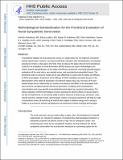| dc.contributor.author | Sakakura, Kenichi | |
| dc.contributor.author | Ladich, Elena | |
| dc.contributor.author | Edelman, Elazer R. | |
| dc.contributor.author | Markham, Peter | |
| dc.contributor.author | Stanley, James R.L. | |
| dc.contributor.author | Keating, John | |
| dc.contributor.author | Kolodgie, Frank D. | |
| dc.contributor.author | Virmani, Renu | |
| dc.contributor.author | Joner, Michael | |
| dc.contributor.author | Edelman, Elazer R | |
| dc.contributor.author | Stanley, James R. L. | |
| dc.date.accessioned | 2017-12-18T15:25:13Z | |
| dc.date.available | 2017-12-18T15:25:13Z | |
| dc.date.issued | 2014-09 | |
| dc.date.submitted | 2014-04 | |
| dc.identifier.issn | 1936-8798 | |
| dc.identifier.uri | http://hdl.handle.net/1721.1/112781 | |
| dc.description.abstract | Transcatheter ablation of renal autonomic nerves is a viable option for the treatment of resistant arterial hypertension; however, structured pre-clinical evaluation with standardization of analytical procedures remains a clear gap in this field. Here we discuss the topics relevant to the pre-clinical model for the evaluation of renal denervation (RDN) devices and report methodologies and criteria toward standardization of the safety and efficacy assessment, including histopathological evaluations of the renal artery, periarterial nerves, and associated periadventitial tissues. The pre-clinical swine renal artery model can be used effectively to assess both the safety and efficacy of RDN technologies. Assessment of the efficacy of RDN modalities primarily focuses on the determination of the depth of penetration of treatment-related injury (e.g., necrosis) of the periarterial tissues and its relationship (i.e., location and distance) and the effect on the associated renal nerves and the correlation thereof with proxy biomarkers including renal norepinephrine concentrations and nerve-specific immunohistochemical stains (e.g., tyrosine hydroxylase). The safety evaluation of RDN technologies involves assessing for adverse effects on tissues local to the site of treatment (i.e., on the arterial wall) as well as tissues at a distance (e.g., soft tissue, veins, arterial branches, skeletal muscle, adrenal gland, ureters). Increasing experience will help to create a standardized means of examining all arterial beds subject to ablative energy and in doing so enable us to proceed to optimize the development and assessment of these emerging technologies. | en_US |
| dc.publisher | Elsevier | en_US |
| dc.relation.isversionof | http://dx.doi.org/10.1016/J.JCIN.2014.04.024 | en_US |
| dc.rights | Creative Commons Attribution-NonCommercial-NoDerivs License | en_US |
| dc.rights.uri | http://creativecommons.org/licenses/by-nc-nd/4.0/ | en_US |
| dc.source | PMC | en_US |
| dc.title | Methodological Standardization for the Pre-Clinical Evaluation of Renal Sympathetic Denervation | en_US |
| dc.type | Article | en_US |
| dc.identifier.citation | Sakakura, Kenichi et al. “Methodological Standardization for the Pre-Clinical Evaluation of Renal Sympathetic Denervation.” JACC: Cardiovascular Interventions 7, 10 (October 2014): 1184–1193 © 2014 American College of Cardiology Foundation | en_US |
| dc.contributor.department | Institute for Medical Engineering and Science | en_US |
| dc.contributor.department | Harvard University--MIT Division of Health Sciences and Technology | en_US |
| dc.contributor.mitauthor | Edelman, Elazer R | |
| dc.contributor.mitauthor | Stanley, James R. L. | |
| dc.relation.journal | JACC: Cardiovascular Interventions | en_US |
| dc.eprint.version | Author's final manuscript | en_US |
| dc.type.uri | http://purl.org/eprint/type/JournalArticle | en_US |
| eprint.status | http://purl.org/eprint/status/PeerReviewed | en_US |
| dc.date.updated | 2017-12-15T16:45:50Z | |
| dspace.orderedauthors | Sakakura, Kenichi; Ladich, Elena; Edelman, Elazer R.; Markham, Peter; Stanley, James R.L.; Keating, John; Kolodgie, Frank D.; Virmani, Renu; Joner, Michael | en_US |
| dspace.embargo.terms | N | en_US |
| dc.identifier.orcid | https://orcid.org/0000-0002-7832-7156 | |
| mit.license | PUBLISHER_CC | en_US |
